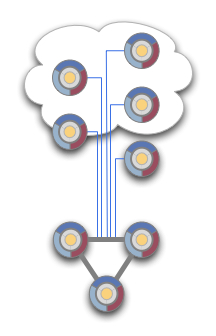Cluster
From Resin 3.0
(Difference between revisions)
| Line 7: | Line 7: | ||
A Resin cluster is a collection of [[server|servers]] which do the same task. For example, all the load-balance servers form a cluster and all the application-servers in the app-tier form a cluster. | A Resin cluster is a collection of [[server|servers]] which do the same task. For example, all the load-balance servers form a cluster and all the application-servers in the app-tier form a cluster. | ||
| + | |||
| + | == example == | ||
| + | |||
| + | A cluster is configured in a <cluster> tag in the resin.conf. | ||
| + | |||
| + | # A set of [[server|servers]], each with its own [[cluster port]] for cluster communication | ||
| + | # A set of virtual hosts, each containing several [[web-app|web-apps]] serving pages | ||
| + | # Shared resources like databases | ||
| + | |||
| + | A cluster with two servers might look like: | ||
| + | |||
| + | === resin.xml === | ||
| + | |||
| + | <resin xmlns="http://caucho.com/ns/resin" | ||
| + | xmlns:resin="http://caucho.com/ns/resin/core"> | ||
| + | <resin:import path="${__DIR__}/app-default.xml"/> | ||
| + | |||
| + | <cluster id="app-tier"> | ||
| + | <server id="a" address="192.168.0.10" port="6800"/> | ||
| + | <server id="b" address="192.168.0.11" port="6800"/> | ||
| + | |||
| + | <host id="www.foo.com"> | ||
| + | <root-directory>/var/www/www.foo.com</root-directory> | ||
| + | |||
| + | <web-app-deploy path="webapps"/> | ||
| + | </host> | ||
| + | </cluster> | ||
| + | </resin> | ||
Revision as of 09:40, 14 January 2009
- Cluster configuration documentation for Resin 4.0 is at http://www.caucho.com/resin/doc/resin-clustering.xtp.
- <cluster> tag documentation for Resin 4.0 is at http://www.caucho.com/resin/doc/resin-clustering.xtp.
A Resin cluster is a collection of servers which do the same task. For example, all the load-balance servers form a cluster and all the application-servers in the app-tier form a cluster.
example
A cluster is configured in a <cluster> tag in the resin.conf.
- A set of servers, each with its own cluster port for cluster communication
- A set of virtual hosts, each containing several web-apps serving pages
- Shared resources like databases
A cluster with two servers might look like:
resin.xml
<resin xmlns="http://caucho.com/ns/resin" xmlns:resin="http://caucho.com/ns/resin/core"> <resin:import path="${__DIR__}/app-default.xml"/> <cluster id="app-tier"> <server id="a" address="192.168.0.10" port="6800"/> <server id="b" address="192.168.0.11" port="6800"/> <host id="www.foo.com"> <root-directory>/var/www/www.foo.com</root-directory> <web-app-deploy path="webapps"/> </host> </cluster> </resin>
